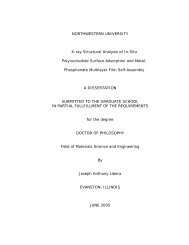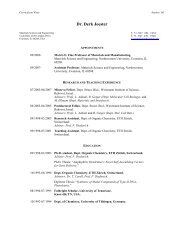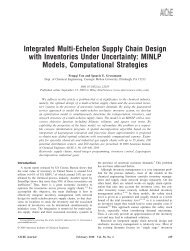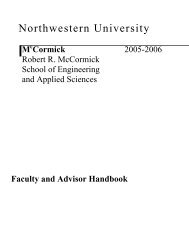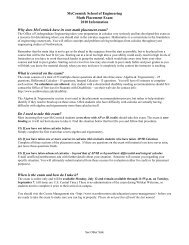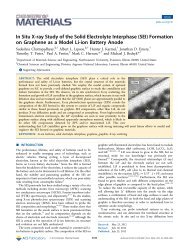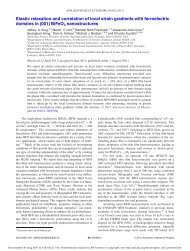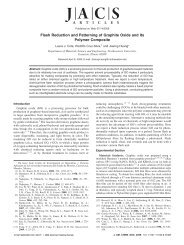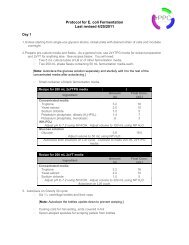Community-Based Operations Research - Humanitarian Logistics
Community-Based Operations Research - Humanitarian Logistics
Community-Based Operations Research - Humanitarian Logistics
You also want an ePaper? Increase the reach of your titles
YUMPU automatically turns print PDFs into web optimized ePapers that Google loves.
Johnson and Smilowitz: <strong>Community</strong>-<strong>Based</strong> <strong>Operations</strong> <strong>Research</strong>104 Tutorialsin <strong>Operations</strong><strong>Research</strong>, c○ 2007 INFORMS<strong>Community</strong>-based OR has its roots in a classic article by Ackoff [2] describing community-engagedproblem solving in a distressed, mostly African American community inPhiladelphia. This amalgam of analysis, action, and advocacy received the greatest attentionin the United Kingdom during the 1980s and 1990s as community operational research(Jackson [37], Parry and Mingers [73], Taket and White [83]), although some attention hasbeen given to this sort of OR practice and theory in the U.S. (e.g., Bajgier et al. [5]). Animportant goal of this tutorial is to respond to Parry and Mingers’ statement that “verylittle has been published on <strong>Community</strong> OR, and as a result it is unclear how much asbeen achieved” ([73], p. 580). These authors demonstrated that much of the work in communityOR appeared to consist of student projects and community outreach that mightbe classified now as “capacity-building,” rather than applications based on analytic modelsintended to provide specific policy and operational guidance to decision makers in a waythat extends existing theory and methods. Most of the applications of community-based ORdescribed in this tutorial have occurred since Parry and Mingers’ [73] article, and addressthe methodological concerns noted above.Certain public-sector problems are not amenable to community-based OR. As mentionedpreviously, many social problems, such as criminal offending, low-quality housing, or inadequateaccess to retail food outlets exhibit symptoms that vary across neighborhoods. Theseproblems may also have important regional or national characteristics that are aggregates ofindividual outcomes, for example high incarceration rates, residential segregation, or adversehealth outcomes related to food insecurity. In turn, these high-level characteristics may beassociated with regional or national-level policy failures, such as ineffective national drugenforcement policy, inadequate funding for affordable housing, or insufficient incentives forgrocery stores to locate in underserved communities. An important area of public-sectorOR, referred to by Kaplan [52] as policy modeling, uses stylized models inspired by problemsof a local nature that may generate important insights regarding regional or national-levelpolicy design. Policy modeling has yielded novel and influential insights in drug policy (seee.g., Rydell et al. [79]), crime policy (see e.g., Blumstein et al. [12]), and public health (seee.g., Kaplan and Merson [55]). <strong>Community</strong>-based OR, although quite distinct from policymodeling, can complement policy modeling by generating solutions associated with directand rapid improvements in individual and neighborhood-level outcomes.We may summarize the defining characteristics of community-based OR problems as follows.They tend to have multiple stakeholders and multiple decision makers (Gass [26],Bardach [8]). We enumerate typical stakeholder and/or decision-maker groups as follows.Donors are government, nonprofit, or for-profit organizations whose direct or in-kind contributionssupport service provision. Clients are individuals, families, or organizations whobenefit directly from service provision. Nonclient residents are individuals, families, or organizationswho benefit indirectly or not at all from service provision but who may neverthelesspay for it through taxes. Service providers are government or non-profit organizations whodesign, implement, and manage service provision strategies. Local government enforces laws,administrative rules, and codes that define the legality of various initiatives. As we haveemphasized, key stakeholders and decision makers are localized and often economically orsocially disadvantaged. Therefore, trade-offs between efficiency, effectiveness, and equity areessential. In contrast to other private- and public-sector OR models, limiting focus to a singledecision maker, stakeholder, or objective function type may obscure important aspectsof the problem at hand.As for United Kingdom-style community OR, successful community-based OR modelsand applications require substantial stakeholder participation in problem definition, solution,and implementation (Bajgier et al. [5], Taket and White [83]). This is incompatible with theconventional “consultant” view of OR modeling in which a dispassionate expert becomesimmersed in a problem domain, formulates and solves an appropriate analytical model, andpresents a range of recommendations to decision makers.



